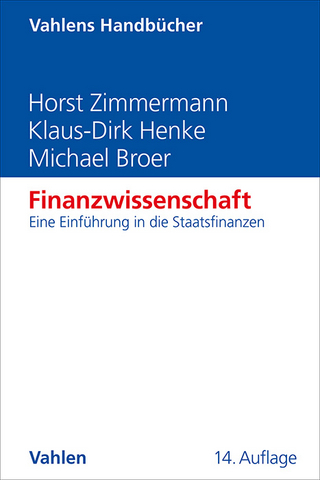
Combating Money Laundering and Terrorist Financing
Commonwealth Secretariat (Verlag)
978-0-85092-842-6 (ISBN)
The first edition of this book was published in 2005, and this second edition now includes additional information on understanding how terrorism is financed. The book incorporates both the international standard arising from the revised Financial Action Task Force on Money Laundering 40 Recommendations and the Special Nine Recommendations.
The manual will be of great use to policy-makers, regulators, financial institutions, the professions and other designated businesses in their efforts to develop viable AML/CFT systems.
The publication is divided into three main parts: the first deals with global issues, the second with national issues and in particular, national strategy formulation; and the third with financial and professional sector procedures.
Preface to the First Edition
Preface to the Second Edition
PART I Global Issues, Strategies and Standards
1. Background and Information
1.1 A Global Problem and Global Solutions
1.2 Development of Commonwealth Anti-Money Laundering Strategies and Policies
1.3 Purpose, Objectives and Status of the Model of Best Practice
1.4 How to Use the Model of Best Practice
2. Money Laundering: The Need for Action and the Benefits to be Obtained
2.1 What is Money Laundering?
2.2 Why Take Action
2.3 The Importance of Regional and National Initiatives: The Link to Economic Development and International Recognition
2.4 The Money Laundering Process
2.5 Basic Principles of Money Laundering Prevention
2.6 The Benefits of Reduced Vulnerability
3. Understanding How Terrorism is Financed
3.1 What is Terrorism?
3.2 Characteristics of Terrorist Financing
3.3 Sources of Terrorist Financing
3.4 Laundering of Terrorist-related Funds
3.5 Recognising Terrorist Financing
3.6 Sanctions and Sources of Information
4 Development of International Initiatives and Standards
4.1 Establishing the International Initiatives
4.2 Enhanced International Financial Regulation
4.3 The International Monetary Fund
4.4 Action Against Non-co-operative Countries and Territories
5 Establishing International and Regional Co-operation
5.1 Co-operation between Governments
5.2 Co-operation through Regional Bodies
PART II National Issues and Strategies
6 Developing National Strategies
6.1 The Basis of Successful Anti-Money Laundering Strategies
6.2 Recognising Issues of US Extra-territoriality
6.3 Developing Strategies for Offshore Financial Centres
6.4 Establishing Co-operation and a 'Partnership Approach'
6.5 The Development of Policies
6.6 Identifying High-risk Business
6.7 Identifying the Risks and Requirements for E-commerce and Internet Financial Services
6.8 Managing the Displacement Factors: Parallel Economies, Underground Banking and Alternative Remittance Systems
6.9 Increasing Public Awareness
7 Criminalising Money Laundering
7.1 Scope of the Criminal Offence of Money Laundering
7.2 The Elements of the Vienna Convention
7.3 The Elements of the Palermo Convention
7.4 The Commonwealth Model Law
7.5 The Inclusion of Economic Crimes within Money Laundering Offences
7.6 Bribery and Corruption
7.7 Secrecy versus Confidentiality
7.8 Implementing a Requirement to Report Knowledge/Suspicion of Money Laundering
8 Setting Obligations for the Financial Sector, the Professions and Other Designated Businesses
8.1 General Requirements
8.2 Defining the Scope of Financial Sector Activities
8.3 Determining the Scope and Vulnerability of Non-financial Sector Businesses and Professions
8.4 Regulations for Financial Institutions, Professions and Other Designated Businesses
8.5 The Role of the Supervisory Authorities
8.6 Establishing Partnership and Commitment
9 Processing Reports, Investigation, Prosecution and Confiscation
9.1 Establishing a Central Reporting Agency
9.2 Processing Reports
9.3 Investigating Reports
9.4 Establishing Confidentiality and Controls
9.5 Obtaining Evidence for Use in Investigations
9.6 Providing Feedback from the Investigating Agency
9.7 Compilation of Statistics and Trends
9.8 Powers to Trace, Freeze and Confiscate the Proceeds of Crime
PART III Financial and Professional Sector Procedures
10 Internal Controls, Policies and Procedures
10.1 Duty to Establish Policies and Procedures
10.2 The Need to Tailor Policies and Procedures
10.3 Appointment of Money Laundering Reporting Officer
10.4 The Objectives of a Compliance Policy
10.5 Compliance Monitoring and Auditing
10.6 Communication of Policies to Staff
10.7 Group Policies
11 Establishing Customer Due Diligence Procedures
11.1 'Know Your Customer' - The Basis for Recognition and Reporting
11.2 The Duty to Verify Identity
11.3 Establishing Identity
11.4 Introduced Business: Reliance Between Regulated Institutions
11.5 Knowing the Customer's Business
12 Recognition and Reporting of Suspicions
12.1 Compulsory Transaction Reporting
12.2 The Obligation to Report Knowledge or Suspicion of Money Laundering
12.3 'Know Your Customer': The Basis for Recognising Suspicions
12.4 Reporting Suspicions
12.5 The Role of the Money Laundering Reporting Officer
12.6 Reporting Suspicions to the Authorities
12.7 Confidentiality of Disclosures - Tipping Off
12.8 Liaising with the Investigating Agencies
13 Retention of Records
13.1 General Principles and Objectives
13.2 Identity Records
13.3 Transaction Records
13.4 Records of Suspicion Reports
13.5 Format and Retrieval of Records
13.6 Group Record Retention Policy
13.7 Wire Transfer Transactions
14 Awareness Raising and Training
14.1 Communicating Information to Staff
14.2 Training
14.3 Keeping Records of Training
Appendices
| Erscheint lt. Verlag | 1.8.2006 |
|---|---|
| Verlagsort | London |
| Sprache | englisch |
| Maße | 165 x 240 mm |
| Themenwelt | Wirtschaft ► Volkswirtschaftslehre ► Finanzwissenschaft |
| Wirtschaft ► Volkswirtschaftslehre ► Makroökonomie | |
| ISBN-10 | 0-85092-842-7 / 0850928427 |
| ISBN-13 | 978-0-85092-842-6 / 9780850928426 |
| Zustand | Neuware |
| Haben Sie eine Frage zum Produkt? |
aus dem Bereich


